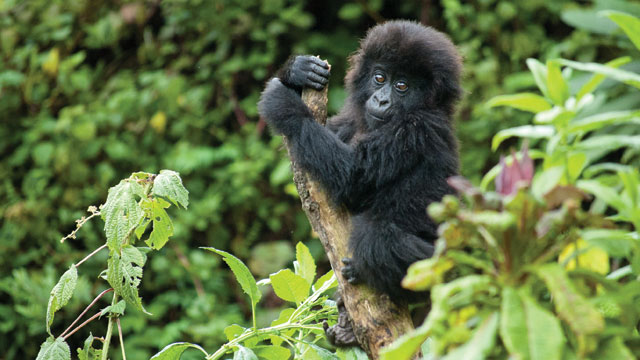TOP STORIES
Gorilla Warfare: As ecotourism becomes more popular, wild apes are succumbing to human diseases
 In late June 2009, a small group of mountain gorillas in Rwanda’s Volcanoes National Park began to fall ill. One by one, 11 of the dozen apes started exhibiting severe respiratory problems. Within days of the park researchers’ noticing the outbreak, one adult female and her 4-year-old son went missing from the group. When wildlife veterinarian Jean-Felix Kinani and his colleagues went looking for the pair, they found the mother lying dead, face down on the ground. Her 4-year-old son sat beside her, “vocalizing, calling other gorillas,” Kinani recalls. Kinani helped treat the young male gorilla with the antibiotic ceftriaxone, returned him to the group, and brought the mother’s body back to the lab for necropsy.
In late June 2009, a small group of mountain gorillas in Rwanda’s Volcanoes National Park began to fall ill. One by one, 11 of the dozen apes started exhibiting severe respiratory problems. Within days of the park researchers’ noticing the outbreak, one adult female and her 4-year-old son went missing from the group. When wildlife veterinarian Jean-Felix Kinani and his colleagues went looking for the pair, they found the mother lying dead, face down on the ground. Her 4-year-old son sat beside her, “vocalizing, calling other gorillas,” Kinani recalls. Kinani helped treat the young male gorilla with the antibiotic ceftriaxone, returned him to the group, and brought the mother’s body back to the lab for necropsy.… As more gorillas began to fall victim to the mysterious disease, the veterinarians on site delivered antimicrobial therapy, and the group suffered just one more casualty—a 3-day-old infant. Kinani and his colleagues shipped tissue samples from the two deceased animals to collaborators at Columbia University’s Center for Infection and Immunity to have a closer look. “We are known to have tools to find the needle in the haystack,” says Center experimental pathologist Gustavo Palacios.
...Sequencing the virus confirmed its identity, and a phylogenetic analysis suggested that the likely origin of the virus was a recent outbreak of hMPV in South Africa. “There was transmission between humans and gorillas within months, probably weeks, maybe even days,” Cranfield says.
Cranfield hasn’t pinpointed where or when humans infected the Rwandan gorillas, but the broader goal is to continue encouraging ecotourism—which has actually helped increase gorilla populations by 26 percent in the past 7 years—while safeguarding the animals from human disease. Simple precautions, such as wearing surgical masks or increasing the minimum distance between visitors and wildlife, can help curb transmission.
The Scientist - www.the-scientist.com
01 Oct 2011
>>> FULL ARTICLE
01 Oct 2011
>>> FULL ARTICLE
Tuna joins ranks of puzzling wildlife deaths on New Hampshire beaches
A dead eight-foot-long bluefin tuna washed up on a beach in New Hampshire Wednesday, the latest of a number of sea creatures whose bodies have mysteriously washed up on the state’s shore.
“All of this together is very concerning,” said Ellen Goethel, a marine biologist and vice chair of the Hampton Conservation Commission.
Goethel’s 31-year-old son found the tuna when he was walking Plaice Cove Beach in Hampton. Goethel, who went to the beach to observe the fish, said she had seen five dead seabirds and three dead seals on the beach the week before.
“I don’t believe that it was caught and lost. It wasn’t injured from fishing,” Goethel said.
The New England Aquarium said last week that a dozen seal pups had washed up on the state’s beaches.
The aquarium is conducting tests on the creatures to determine if disease could be the cause of death. The tests are not expected back until Thursday, Tony LaCasse, spokesman for the aquarium, said today. Tests are also being conducted on the dead birds, said Allison McHale, fishery policy analyst with the National Oceanic and Atmospheric Administration.
The Boston Globe - www.boston.com
07 Oct 2011
Location: Hampton, New Hampshire, USA - Map It
>>> FULL ARTICLE
07 Oct 2011
Location: Hampton, New Hampshire, USA - Map It

>>> FULL ARTICLE
OTHER WILDLIFE HEALTH RELATED NEWS
Photo courtesy of The Guardian's Week in Wildlife
 Comment on squirrel pox outbreak in Florida, USA [Key Largo - Map It
Comment on squirrel pox outbreak in Florida, USA [Key Largo - Map It  and Islamorada - Map It
and Islamorada - Map It  , Florida, USA ]
, Florida, USA ] - Fungus and the Future of Bats
- Public health implications of an outbreak of rabies in arctic foxes and reindeer in the Svalbard archipelago, Norway, September 2011 (Svalbard Archipelago, Norway - Map It
 )
) - Pharmaceutical compounds contaminate the Great Lakes
- Raw sewage: Home to millions of undescribed viruses




